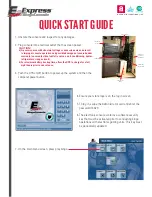
4.3.6.3
Override
Overview
An override is a manual muting triggering after an error in the muting conditions. The
protective device is bypassed and the system can be cleared and an error-free status
can be achieved.
Override is always active if muting has been configured.
Important information
NOTE
If automatic measurement of the protective field width is configured and the protective
field is interrupted when the ESPE is switched on for the first time, the system changes
to the override condition if the override conditions are fulfilled. If override is performed,
the OSSDs change to the OFF state again after the protective field frees up again, if
necessary, until the protective field width is automatically measured.
Configure a dynamic protective field width to bypass this behavior.
Prerequisites
•
The override control switch is mounted outside of the hazardous area so that it
cannot be actuated by a person that is inside the hazardous area.
•
The operator can oversee the entire hazardous area when actuating the control
switch.
Performing an override with the integrated override function
An error occurs while a muting condition is valid. The cause of the error is indicated by
the LEDs on the receiver. If an optional muting light is connected, this muting light also
flashes.
At the same time, the output signal switching devices (OSSDs) switch to the OFF status.
The system is in the override required status and waits for the operator to actuate the
override control switch or for the cause to be remedied in another way, e.g. for the belt
to be cleared.
The status override required is only triggered by the system if the following 3 condi‐
tions are present:
•
An error occurs, i.e. at least one muting sensor is active and at least one is
inactive
•
Muting ends
•
The ESPE is interrupted by an object
Performing an override
The system is in the override required status after an error. Muting can only continue at
the point where it was interrupted if the operator starts the integrated override function
using the control switch. Then, the output signal switching devices (OSSDs) change to
the ON status and the system monitors the override status.
If reset and override are configured, both functions are started using a common control
switch.
Monitoring override statuses
For reasons of safety, the number of override statuses is limited to 5. The system
automatically resets the counter each time the system is activated and after every
error-free muting cycle without an override.
If the permitted number of override statuses has been exceeded, the system then
switches to the locking status and displays an error message.
PROJECT PLANNING
4
8021645/1EB0/2022-04-28 | SICK
O P E R A T I N G I N S T R U C T I O N S | deTec4
43
Subject to change without notice















































